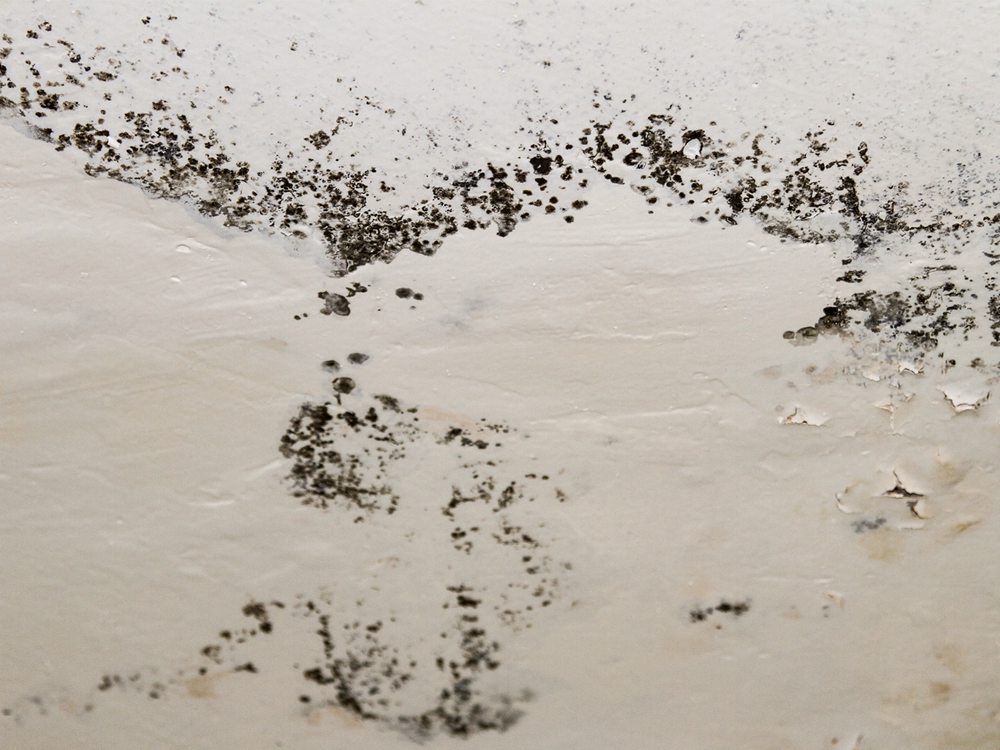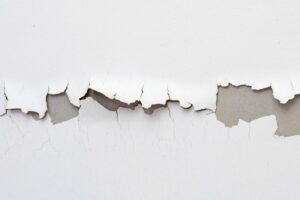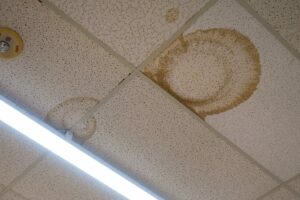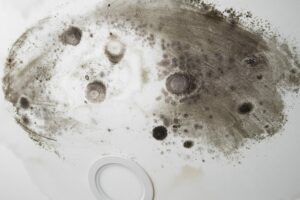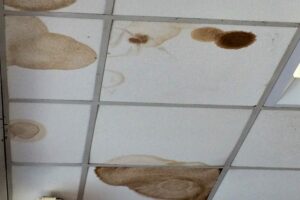Black mold is a common issue in bathrooms that can damage ceilings, walls, and other surfaces. Understanding what causes black mold to grow in your bathroom is the first step to preventing and removing it.
Table of Contents
What is Black Mold?
Black mold, also known as Stachybotrys chartarum or Stachybotrys atra, is a greenish-black mold that grows on materials with high cellulose content like drywall, wood, paper, fiberboard, and ceiling tiles. This mold grows in warm, damp, humid environments with little air circulation.
While there are many types of mold that can grow in the home, black mold is concerning because it produces mycotoxins that can cause health issues in humans and animals when inhaled or ingested. Black mold exposure is particularly dangerous for people with compromised immune systems, respiratory issues, and allergies or asthma.
Signs of Black Mold on Bathroom Ceilings
It is important to identify black mold early before major growth and property damage occurs. Signs to look for include:
- Black, greenish or grayish spotting or discoloration on ceiling
- Water stains or moisture collecting on ceiling
- Patchy or fuzzy texture
- Musty, earthy odor
- Warping, soft spots, or sagging drywall
The mold may start in a small area around a water leak or humid corner. It can spread outwards if excess moisture persists.
Look for mold signs in the following bathroom ceiling locations:
- Near vents or fans
- Above shower or tub surround
- Above sinks, toilets or other water sources
- Corners and edges
- By windows or exterior walls
- Near ceiling light fixtures
| Location | Reason for Mold Growth |
|---|---|
| Near vents or fans | Condensation drips from vent. Poor insulation leads to moisture. |
| Above shower or tub | Steam from hot showers condenses on ceiling. Shower leaks cause water damage. |
| Above sinks, toilets | Leaky plumbing drips water onto ceiling. Condensation from running hot water. |
| Corners and edges | Poor insulation and air circulation causes moisture buildup. |
| By windows or exterior walls | Temperature differences cause condensation on cold ceiling surfaces. |
| Near ceiling light fixtures | Condensation from fixture. Slow roof leaks travel along wires/fixtures. |
Inspect the ceiling closely if you notice musty odors, humidity issues, plumbing leaks, or visible moisture on the ceiling surface. Act quickly to resolve mold issues before major growth occurs.
Health Effects of Black Mold Exposure
Inhaling or touching black mold spores, mycotoxins, and fungal fragments can lead to a variety of symptoms and health issues:
Allergic Reactions
Mold allergies are common, causing respiratory symptoms like wheezing, coughing, eye/nose irritation, congestion, sneezing, sore throat, and sinus infections. Severe reactions can trigger asthma attacks. Those with mold allergies should take precautions around any areas with black mold present.
Respiratory Problems
Toxins produced by black mold are irritating to the lungs and respiratory system. Exposure can worsen conditions like asthma, chronic obstructive pulmonary disease (COPD), pneumonia, and bronchitis. Those with weakened immune systems or lung disease are at higher risk.
Skin Irritation
Direct contact with black mold may lead to symptoms like rashes, hives, and skin irritation or infections. Those with open cuts or wounds should avoid exposure.
Weakened Immune System
The toxins from black mold act as immunosuppressants that can impair your immune system over time. This makes you more vulnerable to illness and infection.
Neurological Issues
Black mold exposure may lead to headaches, memory loss, mood changes, trouble concentrating, numbness, and tremors. Severe toxic exposure can even cause neurological damage.
Reproductive Problems
Studies indicate black mold may interfere with reproduction and fertility due to its toxic effects. Miscarriages and birth defects have also been associated with heavy exposure.
Seek medical advice if black mold exposure leads to persistent or worsening health issues. People with respiratory conditions, allergies, or weakened immune systems may need to leave the affected area until mold remediation is complete.
What Causes Black Mold on Bathroom Ceilings?
There are a few key factors that lead to black mold growth on bathroom ceilings:
Moisture and Humidity
Moist, humid conditions are ideal for mold growth. Bathrooms tend to be damp spaces, with humidity from hot showers, steam from baths, and leaks from plumbing fixtures. If moisture gets into the drywall or accumulates on the ceiling, black mold can start to colonize.
Prolonged moisture on the ceiling from condensation, leaks, or flooding allows mold spores already present in the air to germinate and grow. Mold can start developing in as little as 48 hours in damp conditions.
Low Air Circulation
Stagnant air provides an environment for mold growth. Many bathrooms lack sufficient ventilation to remove humid air and prevent condensation on surfaces. Windows are often small or non-existent, while exhaust fans may be old, undersized, or improperly used.
Dead spots can occur in corners, closets, and ceiling areas without air movement. Trapped moisture in these stagnant sites promotes black mold.
Cellulose-Rich Materials
Black mold feeds on materials high in cellulose like drywall, wood, and ceiling tiles. Most bathroom ceilings consist of drywall, providing an ideal food source. Mold growth will damage the paper facing, gradually spreading across the ceiling over time.
Drywall facing damage may start in damp corners or areas affected by small leaks. Eventually, the entire ceiling can become compromised and require replacement if the moisture issue is not addressed.
Warm Temperatures
Black mold thrives in warm conditions between 40-100°F. Most bathrooms are kept within this ideal temperature range. Combined with moisture and humidity, warm bathroom temperatures accelerate mold growth.
Roof and Plumbing Leaks
Leaks are a common source of excessive moisture leading to black mold on bathroom ceilings:
- Roof leaks can allow water to soak ceilings and walls, especially around vents, chimneys and skylights. Discolored or bubbling areas on a ceiling may indicate an active leak.
- Plumbing leaks from pipes, toilet tanks, faucets, showerheads and tubs can leak over time. Condensation from pipes may also dampen ceiling areas.
- Floods from blocked toilets, overflowing sinks or tubs, and malfunctioning appliances like water heaters can flood a ceiling.
Condensation and Humidity
Daily activities like showering and bathing raise humidity levels. Without adequate ventilation, condensation can form on cool ceilings and drip down walls, allowing mold to colonize. Condensation usually appears first on corners and edges.
Outside humid conditions in southern climates can also drive moisture into poorly insulated bathrooms. Air conditioner duct leaks may drip condensate onto ceilings as well.
Testing for Black Mold
If you suspect black mold growth in your bathroom, it’s important to test and identify the exact species present before attempting removal. Testing can be done through:
Physical Inspection
A trained professional mold inspector can identify areas of mold growth during a physical inspection. They can take samples for lab analysis, use moisture meters to pinpoint moisture issues, and assess if HVAC systems or hidden areas have mold present. This provides a thorough investigation of the scope of the problem.
Swab Sampling
A mold professional can take small surface samples by lightly swabbing visible mold with a sterile swab. The swab is then sent to a lab where the mold species is identified under a microscope. Swab testing can distinguish black mold from other less toxic types.
Air Sampling
Special high-volume pumps are used to take air samples to test for airborne mold spores. The presence of Stachybotrys chartarum spores indicates black mold growth somewhere in the area tested. Air testing can uncover hidden mold that cannot be visually detected.
Lab Analysis
Culturing mold samples at a mycology lab allows precise identification of the mold species. Samples are taken from both visible mold and ceilings/walls in problem areas. The species, spore counts, and any mycotoxin presence is analyzed.
Professional mold testing provides exact identification of black mold, the severity of growth, and impacted areas. This guides appropriate remediation.
How to Prevent Black Mold on Bathroom Ceilings
Humidity and moisture provide ideal conditions for mold growth. Stopping moisture build-up is the #1 defense against black mold in bathrooms. Here are ways to do that:
1. Maintain Proper Ventilation
Proper airflow discourages condensation which allows surfaces to fully dry.
Use exhaust fans:
- Run the bathroom exhaust fan during and at least 15 minutes after showering or baths.
- Make sure the exhaust fan is actually ventilating to the outside, not just recirculating air.
- Consider installing a humidity-sensing automatic exhaust fan if you don’t already have one.
Keep windows open:
- Crack the bathroom window open during and after showering to let fresh air circulate.
- Open blinds/curtains to allow light and air in.
Keep doors open:
- Leave the bathroom door open as much as possible so air can flow in from other parts of the home.
2. Address Humidity Issues
In addition to running fans and opening windows, you may need to address high humidity levels in the bathroom itself.
Use a dehumidifier:
- A dehumidifier extracts moisture from the air. Look for ones made especially for smaller bathrooms.
- Try to keep relative humidity under 50%.
Get a hygrometer:
- This small device measures humidity levels so you can monitor conditions.
- Place it in an out-of-the way spot at eye level.
- Check it daily when first installed to get a base reading.
- Note fluctuations when showering/bathing to see the impact on humidity.
Check for leaks:
- Leaky plumbing like pipes, toilets, and sinks can be a source of excess moisture.
- Repair leaks right away before mold develops.
3. Clean and Disinfect Regularly
Like other microbes, mold spores thrive on grime. Regular cleaning and disinfecting removes their food source.
Clean surfaces weekly:
- Use a bathroom cleaner made specifically for soap scum, mildew, and mold.
- Spray shower walls, tiles, tub, sink, countertops and safely behind/under fixtures.
- Scrub and rinse thoroughly.
Disinfect every 1-2 weeks:
- Use a disinfectant labeled as a fungicide or mold killer.
- Spray on all surfaces – tiles, walls, baseboards, windows, sills, caulking, grout.
- Let sit 10 minutes before rinsing.
Sanitize towels/mats:
- Wash bathroom towels, rugs, shower curtains frequently on hot water cycle.
- Replace musty smelling towels right away.
- Pat down surfaces after bathing so pools don’t form on mats/rugs.
Take out trash:
- Empty bathroom trash cans often so food/waste doesn’t accumulate.
4. Fix Moisture Sources
Eliminating excess moisture involves maintaining fixtures in good working order.
Caulk cracks/gaps:
- Caulk around windows, baseboards, joints, fixtures.
- Look for gaps that allow steam/moisture to seep into walls or ceiling.
- Apply bathroom caulk rated for mold prevention.
Repair drips/leaks:
- Fix any leaky faucets, shower heads, toilet tanks.
- Check under sink for pooling water indicating a leak.
Update old fixtures:
- If fixtures are old, consider replacing sink, tub, toilet, tiles.
- Newer fixtures are designed to prevent leaks/condensation.
Insulate pipes:
- Wrap hot water pipes with insulation to reduce condensation.
- Check joints for drips.
5. Improve General Ventilation
Ventilation improvements outside the bathroom also prevent whole home humidity issues.
Install bathroom exhaust fan ducting:
- Ensure exhaust fan ducting terminates completely outside, not just in attic space.
- Use rigid metal ducting, not plastic which can sag and accumulate moisture.
Upgrade HVAC air filters:
- High efficiency pleated filters reduce indoor pollutants and allergens.
- Change per manufacturer’s recommended schedule.
Consider a whole house dehumidifier:
- If humidity levels are high throughout the home, a whole house dehumidifier can help.
- They tie directly into the home’s ductwork to dehumidify every room.
Seal HVAC ductwork:
- Leaky ductwork can introduce warm moist air into walls/ceilings promoting mold growth.
- Have a professional inspect and seal ductwork with mastic.
Install bathroom exhaust fan timers:
- Timers allow fans to run for a set time after you leave the bathroom.
- This gives humidity levels extra time to go down before the fan shuts off.
How to Remove Black Mold from Bathroom Ceilings
If black mold colonies have already started growing, you’ll need to take steps to kill and safely remove it.
Wear protective gear:
- Wear gloves, goggles, an N95 mask or respirator to protect yourself from inhaling spores and touching mold.
Isolate the area:
- Close windows and doors and turn off any fans. This keeps spores contained.
- Cover air vents and other rooms with plastic sheeting.
Mix a cleaning solution:
- Make a solution of 1 cup bleach to 1 gallon of water. Or use a commercial mold cleaner.
- Spray mold until completely saturated. Let sit 10-15 minutes.
Scrub and rinse:
- Gently scrub with a stiff brush or sponge. Take care not to break up mold and stir spores into the air.
- Rinse thoroughly until all residue is gone.
Allow area to fully dry:
- Mold cannot recover if conditions are no longer humid. Use fans to completely dry the area.
Discard porous materials:
- Drywall, insulation, carpet, etc harboring black mold may need to be removed and replaced.
- Seal contaminated materials in plastic and discard per local waste regulations.
Paint disinfected areas:
- Paint with mold resistant paint to encapsulate any remaining spores.
- Replace drywall, insulation and other needed repairs.
Check for hidden colonies:
- There may be mold inside ceiling/wall cavities you cannot see. Consider inspection or testing.
- Remediators can cut inspection holes, test air quality, and eradicate hidden colonies.
Stopping black mold requires diligence – moisture control must become part of your bathroom routine. With proper prevention, black mold will not gain a foothold.
How to Fix a Bathroom Ceiling after Mold Removal
After removing all visible mold, fixing ceiling damage helps prevent future mold growth. Recommended repair steps include:
- Repair any leaks or moisture sources like faulty plumbing or poor ventilation.
- Replace severely damaged sections of drywall or plaster. Cut at least 6 inches beyond moldy areas.
- Sand and smooth edges to prepare surfaces for spackling.
- Fill gouges, cracks, and seams with spackling compound for a flat finish.
- Seal cleaned areas with mold-inhibiting primer to prevent spore regrowth.
- Repaint ceiling with mold resistant bathroom paint to help prevent moisture absorption.
- Consider installing moisture-proof drywall, plasterboard, or cement board when replacing large sections.
- Add a humidity sensing bathroom fan.
Making repairs to both aesthetic damage and the root moisture causes leads to long-term solutions.
Dangers of Improper Black Mold Removal
Attempting do-it-yourself removal of black mold on bathroom ceilings can actually make problems worse and release more spores in the home. Improper removal dangers include:
- Spreading spores around the bathroom and home from disturbances during removal.
- Exposure to mycotoxins that cause health issues by inhaling spores during removal without proper respiratory protection.
- Leaving mold roots in place allowing regrowth if surfaces are not adequately cleaned down to the sub-surface level.
- Cross contaminating other areas of the home with spores on clothing, tools, or furnishings.
- Not properly containing and disposing of mold materials allowing re-release of spores.
- Not addressing the original moisture source, allowing the black mold to quickly return and regrow on bathroom ceiling.
- Failing to protect oneself from exposure to mold spores and mycotoxins during the removal process.
Improper mold removal wastes time and money while also compounding the mold issues in the home. Professional remediation is recommended.
Frequently Asked Questions about Black Mold in Bathrooms
1. How can you tell if black stuff on the ceiling is black mold?
Some signs that black spots may be toxic black mold growth rather than mildew or dirt:
- It quickly grows larger over days or weeks
- It has tentacle-like tendrils spreading outward
- It has a greenish/black color
- It has a slimy or powdery appearance
- It’s concentrated in humid areas of the room
- It has a musty, earthy smell
- You notice mold-related health issues
The only way to confirm it’s black mold is to have it lab tested. Some home mold test kits only specify “mold present” without identifying the type. Hire a mold professional for testing to determine if Stachybotrys chartarum toxic black mold is present.
2. What health conditions can black mold cause?
According to the CDC, inhaling high levels of mycotoxins from black mold can lead to:
- Coughing/wheezing/difficulty breathing
- Nose, throat, lung irritation
- Skin irritation
- Eye redness and watering
- Sinus congestion
- Immune issues
- Chronic fatigue
- Headaches/brain fog
Severe or long term exposure may contribute to lung infections, neurological problems, and hemorrhaging. Those with asthma or mold allergies have higher sensitivity. Seek medical care for unexplained chronic conditions that may be mold-related. Children exposed to black mold may experience slowed development and failure to thrive.
3. Can black mold on the ceiling be cleaned or does it need removing?
For small areas of black mold growth less than 10 square feet, non-porous surfaces like painted drywall can often be cleaned and disinfected.
Porous material like ceiling tiles, paper-faced drywall, or cracked/damaged areas are better removed since mold can be difficult to fully eliminate from pores.
Hidden mold growing inside ceiling or wall cavities will also likely require removing contaminated drywall or other materials to access and eradicate it. Consider hiring a mold remediation company for large or hidden colonies.
4. How can you tell if black mold in the ceiling has spread to other areas?
Signs black mold may have traveled to other areas like walls, insulation, or ductwork:
- Expanding water stains spreading outward
- New mushrooms popping up in other locations
- Musty smell throughout the home, not just bathroom
- Mold-related health symptoms
- Discovery of mold behind bathroom walls/fixtures
The only way to check for hidden mold is to visually inspect by removing ceiling/walls, or hire a professional mold inspector. They can check behind bathroom walls, under tubs, around window frames, etc using a boroscope. Air testing can also detect elevated spore levels. Don’t wait until symptoms appear to check for hidden infestation.
5. What is the cost to remove black mold from a bathroom?
According to HomeAdvisor, average costs for black mold removal:
- Small area (10 sq ft) – $500
- Medium area (10-30 sq ft) – $1000
- Large area (30-100 sq ft) – $3000
- Entire bathroom remediation – $5000-$10000
Costs depend on:
- Quantity of contaminated drywall to replace
- Need for structural repairs of water damage
- Extent of HVAC and ductwork cleaning required
- Professional mold inspection/testing fees
- Use of mold killing chemicals/fogging
Homeowner’s insurance may cover portions of damage repair, testing, and temporary displacement costs. Get multiple bids and verify company licensing, insurance, and remediation process.
In Conclusion:
Preventing black mold involves diligent moisture control and cleaning. Promptly fix plumbing leaks, clean with antimicrobial products, improve ventilation, and monitor humidity levels. If black mold is present, take safety precautions during removal. With vigilance, you can keep your bathroom free of black mold and protect your family’s health.


